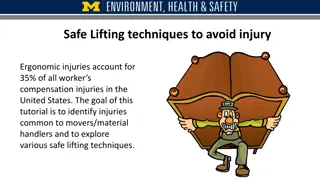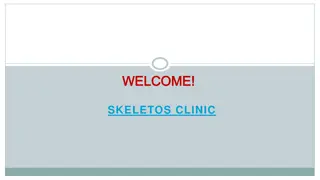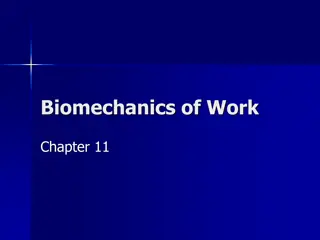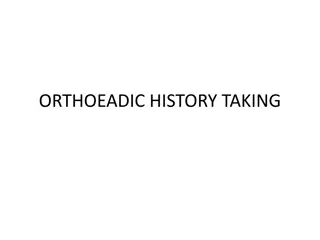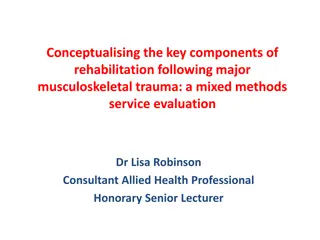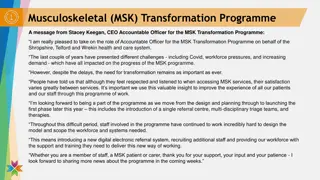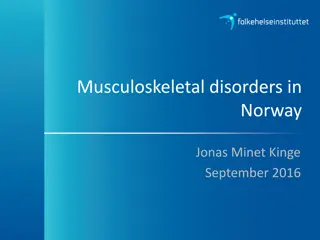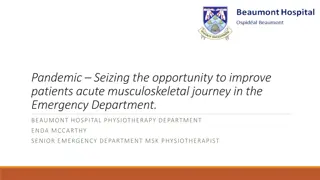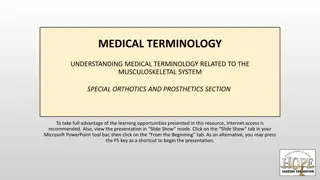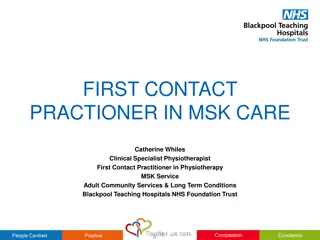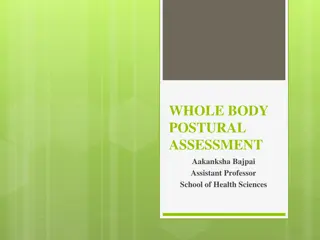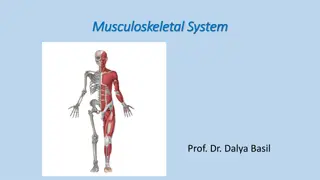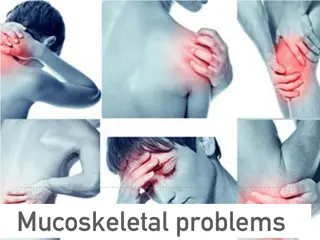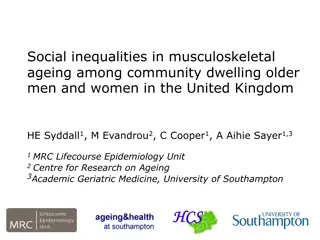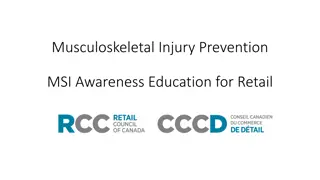Musculoskeletal System Assessment Guidelines
Learn how to conduct a thorough musculoskeletal system assessment, including functional assessments and physical examination guidelines. Explore assessment techniques for ADLs, gait observation, joint palpation, muscle strength testing, and more in nursing practice.
Download Presentation

Please find below an Image/Link to download the presentation.
The content on the website is provided AS IS for your information and personal use only. It may not be sold, licensed, or shared on other websites without obtaining consent from the author.If you encounter any issues during the download, it is possible that the publisher has removed the file from their server.
You are allowed to download the files provided on this website for personal or commercial use, subject to the condition that they are used lawfully. All files are the property of their respective owners.
The content on the website is provided AS IS for your information and personal use only. It may not be sold, licensed, or shared on other websites without obtaining consent from the author.
E N D
Presentation Transcript
University of Basrah College of Nursing Health Promotion Course Fourth Year Students First Semester 2023
Lecture no. 8 Nursing Process Part 2 Lecturer Dr. FirasA. Jasim (MBChB-ABMS-FM) 2023
Musculoskeletal system assessment Functional Assessment: ADLs (activity of daily living) : 1. Toileting. 2. Dressing - buttons - tying shoes. 3. Shaving - brushing teeth. 4. Eating - preparing meals etc 5. Mobility - walking up/down stairs, in and out of car, out of house. 6. Communicating - talking using phone or computer, writing. 7. Occupational / Environmental - heavy lifting, repetitive motions etc.
Physical Assessment Guidelines 1. Observe gait and posture. 2. Inspect joints, muscles, and extremities for size, symmetry, and color. 3.Palpate joints, muscles, and extremities for tenderness, edema, heat, nodules, or crepitus. (Ask painful area, start palpation away from pain, look to patient). 4.Test muscle strength and ROM ) range of motion ) of joints. 5. Compare bilateral findings of joints and muscles.
Spine exam: Have patient bend a waist, note curvature, ease of mobility. Note any spinal deformities. Palpate vertebral column with fingertips, note tenderness or bony deformities. ROM: Flexion and extension. Lateral bending. Spinal rotation.
Neck exam: ROM and muscle strength: Flexion. Extension. Cervical rotation- turn head to Right and Left. Lateral bending- tilt the head to R. and L. shoulders. Repeat against resistance.
Shoulder exam: Assess symmetry and position of clavicles. Palpate clavicles toward shoulders, palpate deltoid muscle. ROM and muscle strength: Flexion Extension Abduction Adduction, Rotation Test muscle strength: shrug
Elbow exam : bend elbow 70 degrees, inspect and palpate posterior surface. Note medial and lateral condyles of humerus and olecranon process of ulna. ROM and muscle strength: Flexion and Extension Supination and Pronation Test muscle strength; flexion/extension
Wrist exam: Grasp wrists, assess body processes of radius (thumb side) and the ulna. Palpate radiocarpal joint and remaining wrist joints. ROM and muscle strength: Flexion. Extension. Radial and ulnar wrist Deviation. Circumduction. Test strength.
Hand exam : Use thumb and forefinger to palpate the metacarpophalangeal and interphalangeal joints. ROM and muscle strength: Flexion Extension Abduction- have patient spread fingers apart Adduction- have pt. hold fingers together Thumb/Finger Opposition
Hip exam Palpate hip joint and surrounding structures. Palpate iliac crest, greater trochanter, hip, thigh and buttock muscles. ROM and muscle strength: Flexion Extension Adduction and Abduction External rotation and Internal rotation Symmetry of length and position
Knee exam: have pt. sitting, dangling. Inspect- note alignment, deformity, contour of quadricep muscle. Palpate the suprapatellarpouch and note any tenderness, edema. ROM and muscle strength: Flexion and Extension
Ankle exam: Compare the contour of R. and L. ankles. Palpate ankle and achilles tendons. ROM and muscle strength: Dorsiflexion Plantar Flexion Inversion Eversion Circumduction Test muscle strength; Plantar & dorsiflexion
Nursing Diagnosis : Is a clinical judgment concerning human response to health conditions. Nursing diagnoses are developed based on data obtained during the nursing assessment and enable the nurse to develop the care plan. Nursing diagnosis is commonly written in (P) , (E) format: # P = Problem. Planning : planning step is aimed to provide consistent, continuous care that will meet the patient s needs. # E = Etiology.
Implementation : Carry out the care plan. - Reassess the patient. - Validate that the care plan is accurate. - Carry out nurses orders. - Document on patient s chart. Evaluation: Compare the patient s current status with the stated patient goals. - Were the goals achieved? Why not?
HOMEWORK Q1/ What are the ADLs (activity of daily living) ? Q2/ Write short notes about Implementation in nursing process?


